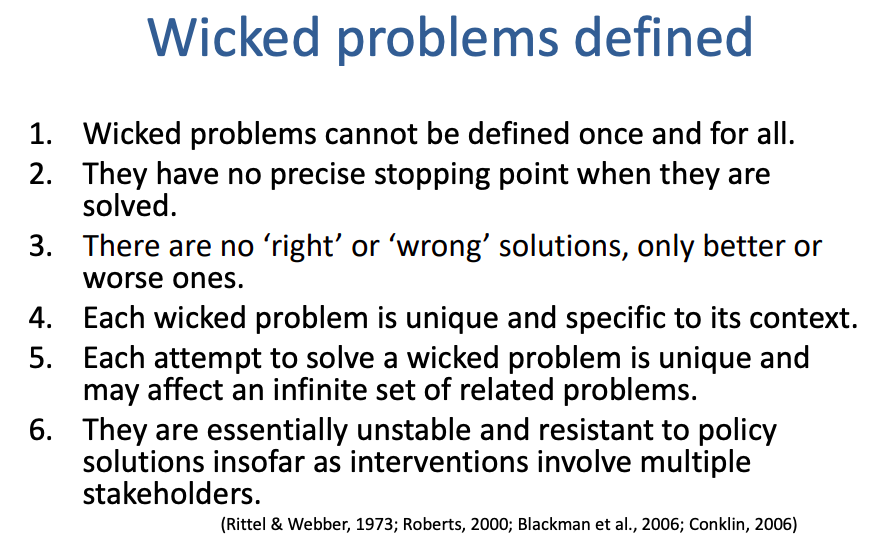THREAD: This wk, @SickKidsNews published a proposed approach to return to school. It generated a spectrum of opinions on social media & TV/radio. https://www.sickkids.ca/PDFs/About-SickKids/81407-COVID19-Recommendations-for-School-Reopening-SickKids.pdf
I& #39;ll">https://www.sickkids.ca/PDFs/Abou... discuss how this is a wicked problem and a #design approach should be used, at least in part.
1/
I& #39;ll">https://www.sickkids.ca/PDFs/Abou... discuss how this is a wicked problem and a #design approach should be used, at least in part.
1/
My disclosure: I am certainly no ID physician or expert on COVID disease transmission but as I’ve written about previously I am interested in decision making under stress, #design and behavior nudges during uncertainty
And I have 2 kids who go to school. So this matters to me
2/
And I have 2 kids who go to school. So this matters to me
2/
I& #39;ll discuss how kids returning back to school is essentially a wicked problem. Not a term I made up, but rather “a problem that cannot be fixed, where there is no single solution”. https://en.wikipedia.org/wiki/Wicked_problem
3/">https://en.wikipedia.org/wiki/Wick...
3/">https://en.wikipedia.org/wiki/Wick...
For those trying still puzzled by a wicked problem… examples include climate change, poverty, food insecurity.
…https://globalizationandhealth.biomedcentral.com/articles/10.1186/s12992-018-0353-x
And">https://globalizationandhealth.biomedcentral.com/articles/... not surprisingly, getting kids back to school, close to each other, w/ fevers & runny nose, to learn...is a wicked problem.
4/
…https://globalizationandhealth.biomedcentral.com/articles/10.1186/s12992-018-0353-x
And">https://globalizationandhealth.biomedcentral.com/articles/... not surprisingly, getting kids back to school, close to each other, w/ fevers & runny nose, to learn...is a wicked problem.
4/
Accepting this as a “wicked” problem then we also approach this issue differently. We need “to shift the goal of action...from "solution" to "intervention."
Recognize that actions occur in an ongoing process, and further actions will always be needed.
http://publicsphereproject.org/content/wholesome-design-wicked-problems
5/">https://publicsphereproject.org/content/w...
Recognize that actions occur in an ongoing process, and further actions will always be needed.
http://publicsphereproject.org/content/wholesome-design-wicked-problems
5/">https://publicsphereproject.org/content/w...
Ok, so now that we& #39;ve acknowledged that we’re not going to “solve” this problem.
Our approach will be iterative, and intervention focused.
6/
Our approach will be iterative, and intervention focused.
6/
We can’t exclusively use the scientific method nor even an authorative approach. Many advocate for a collaborative approach that combines local context, societal considerations and ecological interconnectedness .
https://phabc.org/wp-content/uploads/2019/07/wicked-problems-and-health-inequities.pdf
7/">https://phabc.org/wp-conten...
https://phabc.org/wp-content/uploads/2019/07/wicked-problems-and-health-inequities.pdf
7/">https://phabc.org/wp-conten...
Sending kids back to school using an alternating schedule coupled with a few more hand sanitizers, by definition of a wicked problem, will not offer the outcome we’re looking for. In fact, its even hard to define what we need/want...
https://www.cp24.com/news/lecce-releases-3-option-plan-for-ontario-schools-to-reopen-in-september-1.4991164
8/">https://www.cp24.com/news/lecc...
https://www.cp24.com/news/lecce-releases-3-option-plan-for-ontario-schools-to-reopen-in-september-1.4991164
8/">https://www.cp24.com/news/lecc...
The #design approach to problem solving offers a unique framework and perspective that will serve us well here. An approach first advocated in 1992.
https://web.mit.edu/jrankin/www/engin_as_lib_art/Design_thinking.pdf
https://web.mit.edu/jrankin/w... href=" https://medium.com/age-of-awareness/facing-complexity-wicked-design-problems-ee8c71618966
9/">https://medium.com/age-of-aw...
https://web.mit.edu/jrankin/www/engin_as_lib_art/Design_thinking.pdf
9/">https://medium.com/age-of-aw...
One approach is the 5 phased framework of #DesignThinking
Step 1: involves understanding the end-user. And there are many (kids, parents, teachers etc).
10/
Step 1: involves understanding the end-user. And there are many (kids, parents, teachers etc).
10/
For example, HSC report suggests that kids won’t comply with masks. Do we know this? Did anyone ask them? Or better, did anyone observe them during a school day? I get it, its unlikely my 5yr old will be able to comply all day, but this is not an all or none effect.
11/
11/
It might be that some mask wearing time is likely better than none at all.
As we begin empathizing and understanding the end-users, we’ll start to define the problems. That is, small more digestable problems. Because solving a “wicked problem” has no specific solution.
12/
As we begin empathizing and understanding the end-users, we’ll start to define the problems. That is, small more digestable problems. Because solving a “wicked problem” has no specific solution.
12/
I would suggest that leaders meet & co-design with those involved in the education system. This requires regular consideration of the effects of each proposed action (a 2nd order thinking approach)
https://fs.blog/2016/04/second-order-thinking/
We">https://fs.blog/2016/04/s... can brainstorm solutions then prototype them.
13/
https://fs.blog/2016/04/second-order-thinking/
We">https://fs.blog/2016/04/s... can brainstorm solutions then prototype them.
13/
You wouldn’t drive a car that hasn’t been crash tested, why would we just blindly accept that a new approach to education will be suitable. This will require compromises by multiple entities from governmental, school and teacher/unions levels.
14/
14/
It strikes me as odd to imagine a complete overhaul of the educational system and not crash test the process.
Following a design approach, we should pilot test our design. A few select students/teachers back in August. Get feedback from teachers, students, parents etc.
15/
Following a design approach, we should pilot test our design. A few select students/teachers back in August. Get feedback from teachers, students, parents etc.
15/
Observe kids, teachers etc in the space that has been designed. What are the challenges? What works? What doesn’t. Make changes, rapidly. Then retry. Rome wasn’t built in a day and a massive revision to education certainly won’t be either.
16/
16/
In healthcare we call it simulation, we do this for any new process that we integrate. We should do this from the beginning to the end of the school day. The technology, the in-class elements, the pick-up, drop-off & attention is needed for students with additional needs.
17/
17/
We can’t afford not to take this seriously. This certainly is a wicked problem. But lets acknowledge such and move forward. Education and lives are at stake. Not a heck of a lot more important than that.
end
end

 Read on Twitter
Read on Twitter








